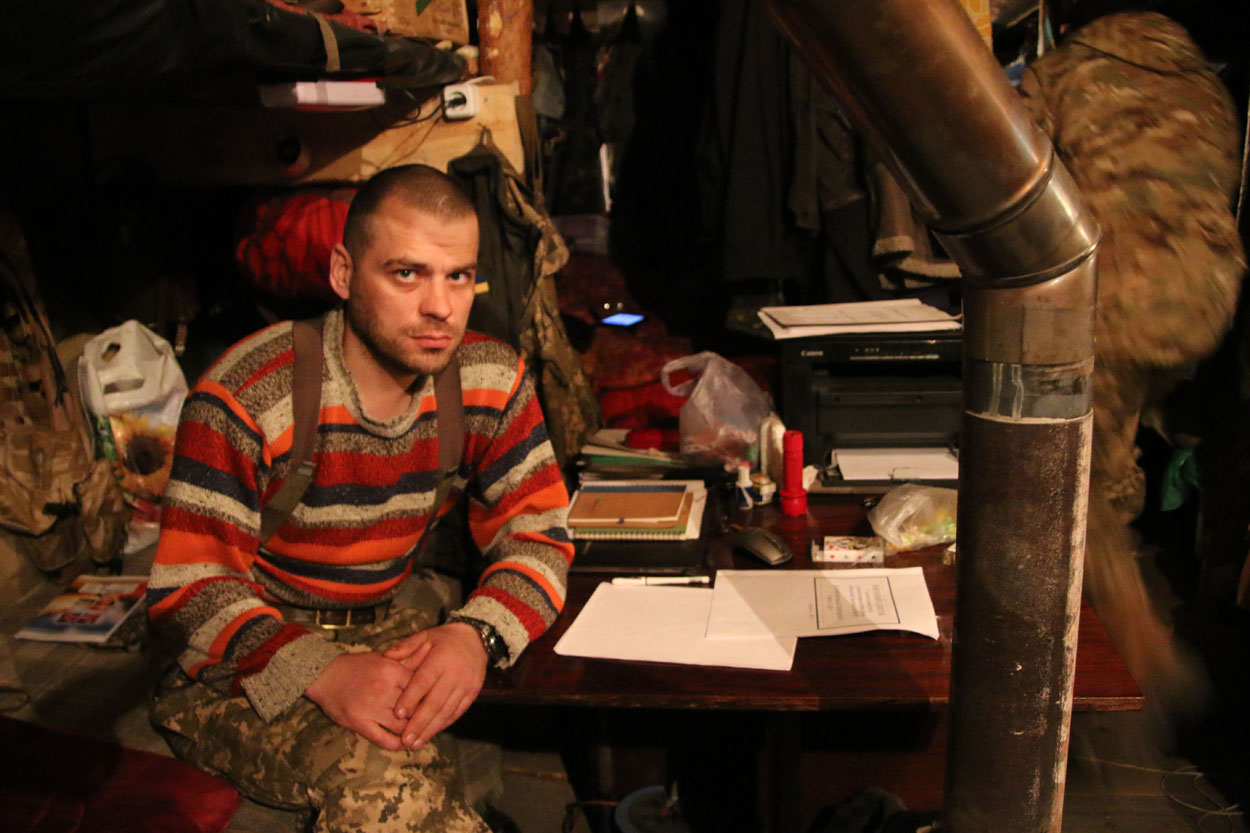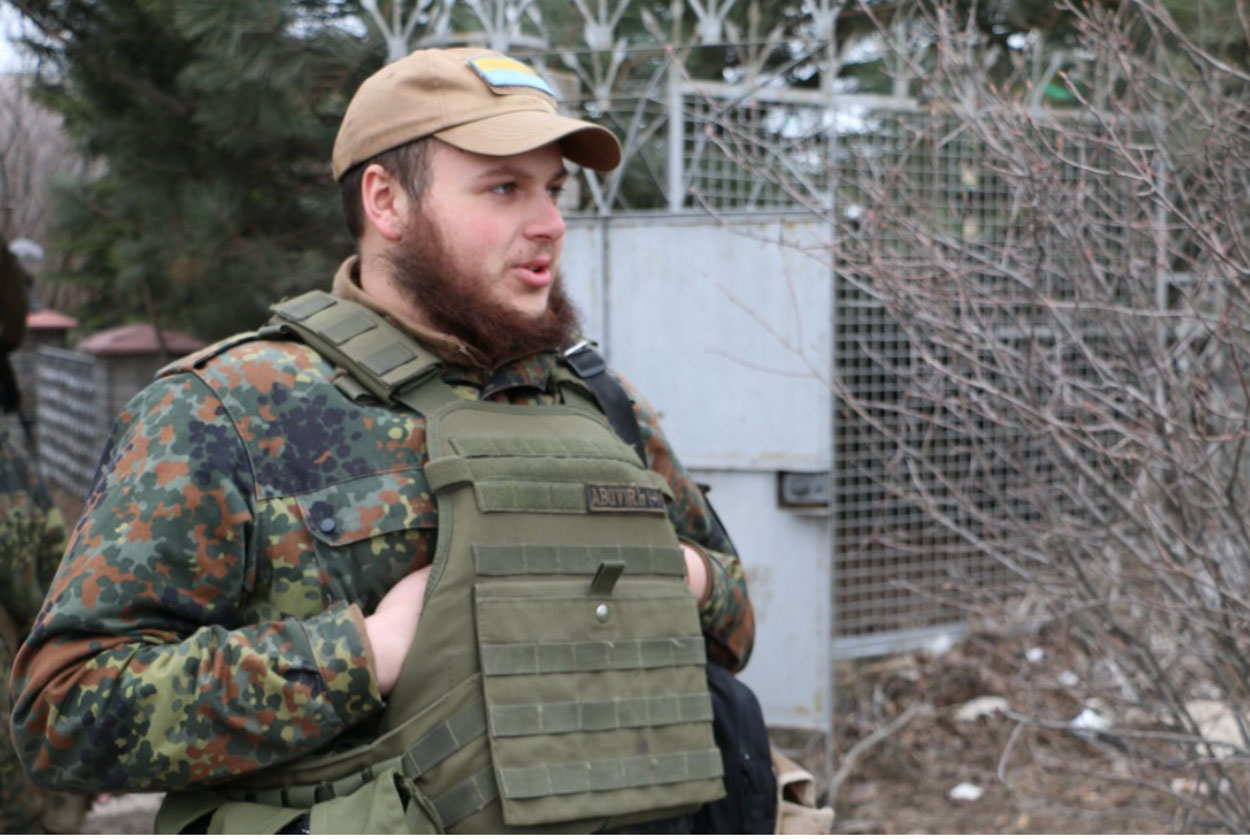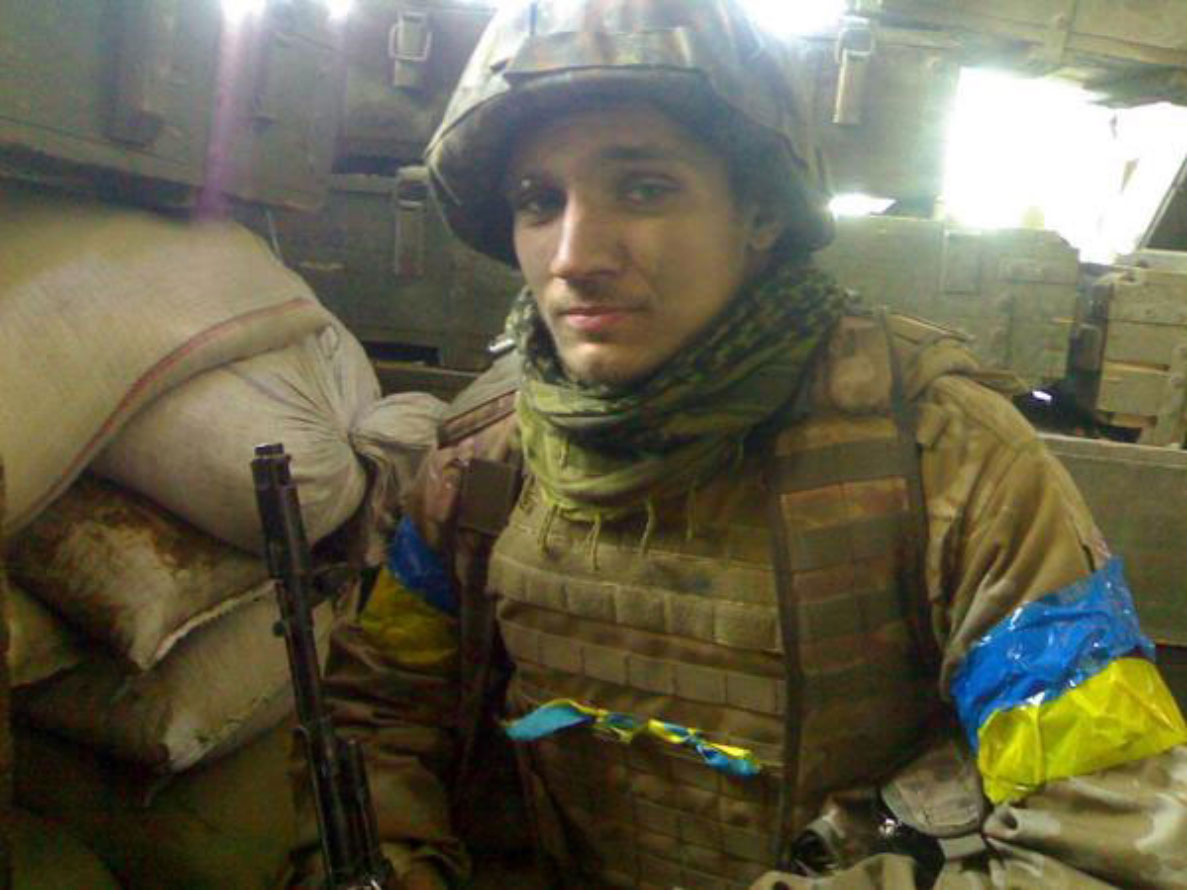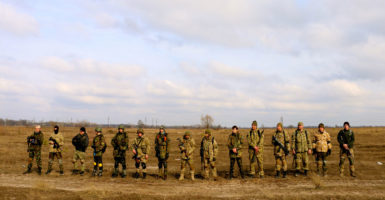KYIV, Ukraine—The trench lines of Europe’s only ongoing land war are six hours away by train from Ukraine’s capital city of Kyiv. But you can hardly tell.
Businesses and bars and universities and protests and politics—in other words, life—all go on and on despite the war.
Yet, the war is always there. Distant and unseen to the physical senses, perhaps, but never truly gone for those who’ve served or for the families of fallen soldiers.
“My war is still going on, and I don’t know when it will finish,” said Ivan Kharkiv, a 24-year-old Ukrainian combat veteran who served from 2014 to 2016 in some of the war’s deadliest battles.
“I was in the war for two years, but I’ve lived four years with the war in my head,” Kharkiv said. “It’s hard to read that your friends who are still in the army are dying. Hard to understand that not all of them came back from war. Hard to know that you can’t help them.”
Today, after four and a half years of constant combat, Ukrainian troops remain hunkered down in trenches and ad hoc forts along a 250-mile-long front line in the country’s embattled, southeastern Donbas region. There, Ukraine’s military continues to fight a grinding, static war against a combined force of pro-Russian separatists and Russian regulars that began in April 2014.
It’s become a long-range battle not unlike World War I trench warfare (albeit on a much smaller scale) in which soldiers hardly ever see at whom they’re shooting. At some places, no man’s land can be several kilometers wide. At others, the Ukrainians and their enemies are close enough to shout insults at each other.

Kyiv’s territorial defense battalion, an irregular military unit, prepares for partisan warfare in 2015. (Photo: Nolan Peterson/The Daily Signal)
So far, more than 10,300 Ukrainians have died in the conflict. The fighting has displaced another 1.7 million people. Europe’s only ongoing land war is also the Continent’s biggest refugee crisis.
For those living within its grasp, the war in Ukraine has become a way of life. Yet, the war’s physical effects are quarantined to an area that extends beyond the front lines only as far as the range of the weapons used.
Life goes on pretty much unaffected by the conflict in cities like Kyiv, hundreds of miles distant from the war zone.
However, if you know what to look for, there are clues to the war’s presence. For example, by all appearances Oct. 3 seemed like a typical day at Taras Shevchenko National University of Kyiv—Ukraine’s premier university.
Students streamed in and out of the university’s buildings, their minds occupied by studies, social lives, and futures. Voices and footfalls echoed in the hallways. Between classes, students and faculty alike angled their shoulders to get through the crowded corridors. Yet, on this day, there was a notable interruption to the normal rhythm of university life.
In a second-floor hallway in the philology department, a crowd of about 50 had gathered. They pressed shoulder to shoulder. Static. Silent.
The crowd extended for dozens of feet down the hallway in either direction from a poster with a picture of Sviatoslav Horbenko, a 19-year-old soldier who died in combat on Oct. 3, 2014, exactly four years earlier.
Horbenko had been a student at Shevchenko University before he went to war; he studied Japanese in the philology department. Without telling his friends, family, or teachers, the impassioned, patriotic young man left his studies in June 2014 to join a volunteer paramilitary unit called Right Sector.
After one month of abbreviated basic training in September 2014, Horbenko arrived on the front lines of the battle for the Donetsk Airport. The Ukrainian soldiers who fought in that battle earned the nickname “Cyborgs,” a reference to the half human, half machine creatures of science fiction. The nickname suits the inhuman conditions they faced.
It was a truly brutal battle. Something like the street fighting in Stalingrad in World War II, or the 1968 battle for Hue during the Vietnam War. The fighting was apocalyptic and total. For months, soldiers on both sides endured near constant shelling, tank shots, and rocket attacks.

A Ukrainian soldier inside a front-line, trench dugout near the city of Luhansk. (Photo: Nolan Peterson/The Daily Signal)
Opposing soldiers sometimes holed up on different floors of the same building, leading to close-quarters gun battles and even hand-to-hand fighting in some instances, according to Ukrainian soldiers who fought at the Donetsk Airport.
“The airport was a massacre,” said Denys Antipov, a Ukrainian army veteran of the war in the Donbas who now teaches Korean at Shevchenko University.
“It was like a sandwich,” Antipov said. “The enemy was below you and always around you—everything was tangled up.”
This hellish battle was Horbenko’s initiation as a soldier, as well as adulthood—he’d gone from living under his parents’ roof to living under Russian artillery with little time in between.
Such an education leaves no room for self-pitying victimhood. The shells and bullets are indifferent to your complaints about the entitlements of others, privilege, micro-aggressions, or triggers. There are no “safe places” in war.
Natural Selection
Horbenko’s abridged military education was supplemented by what many Ukrainian soldiers have jokingly referred to as “natural selection” training, in which young, inexperienced soldiers like Horbenko would shadow the older ones—some of whom were Red Army veterans of Afghanistan—mimicking their moves to stay alive.
By all accounts, Horbenko was a courageous, competent soldier. Yet, in an artillery war, your chances of survival have more to do with blind luck than your courage or combat skills.
The shells and mortars fall where they do, and you have no way to predict the right, or wrong, places to be. You simply do your duty and don’t think about the endless “what ifs”. If you really stopped to think about all the close calls, all the times when the dumb luck of seconds and inches saved your life, then you would simply, certainly be paralyzed with fear.
Thus, the way Horbenko died speaks to the young man’s courage, as well as the indifferent toll that war exacts, even from the very bravest.
On Oct. 3, 2014, Russia’s combined-separatist forces, supported with tanks and artillery, launched an offensive to take the Donetsk Airport. During the battle, Horbenko ran into the line of fire to rescue a comrade taken down by artillery shrapnel. In the melee, shrapnel from an exploding tank shell pierced Horbenko’s carotid artery. Other soldiers tried desperately to staunch the bleeding but were unable to do so.
Horbenko died on the battlefield. He was 19.
As for the wounded soldier Horbenko had tried to rescue—he lived.
‘Nightmare’
On the fourth anniversary of Horbenko’s death, his parents, Sergiy and Lesya, stood with their backs against the wall in the center of the crowd gathered in the second-floor hallway of Shevchenko University’s philology department.
Antipov, the Korean language instructor and war veteran, stood to their left. A reservist, Antipov was in his uniform. Various medals and patches on his tunic speak to his wartime military service. His military bearing was impeccable.
Sergiy spoke for a few moments about his son’s character, and about the reasons his son went to war. The father’s voice was steady, but the pain in his face was clear.
“We always taught him to have pride, to have honor, and to value his freedom,” Sergiy said of his son. “And the freedom of his country as well.”
As he spoke to the crowd, Sergiy’s head was bowed and his hands were clasped in front. When periodically up against the limits of his grief, Sergiy would pause, look down, take a deep breath, and then keep going. At his side, his wife, Lesya, squared her jaw but quietly cried.
In the enveloping crowd most stood silently with heads bowed. Some cried. One woman kept repeating over and over the word “nightmare.”
Meanwhile, the university’s typical weekday din continued on the periphery of the ceremony. At first, the sounds of conversation and laughter jarred against the solemnity of the memorial ceremony.
But then you remember: Life goes on. Even in wartime.
“We are very grateful for the people here today,” Sergiy later told this correspondent. “Of course, it’s hard for us when so many people are gathered. But we understand it’s important for the memory of our son.”
The bereaved father paused for a beat, as was his habit to keep the grief at bay. He steadied his demeanor and then added, “We are proud, we are proud.”
Coming Home
The hardest part of war is often the coming home. Wars, after all, never really end for those who fight in them. Yet, at some point, every soldier has to stop going to war.
“The first couple months after war were the worst in my life,” said Kharkiv, the 24-year-old Ukrainian veteran. “And the first year after war was worse than war.”
Kharkiv was 20 and a university student in 2014 when he volunteered to serve with what is now the Ukrainian National Guard’s Azov Regiment. At the time, the unit was still a volunteer, paramilitary force.
“A lot of young guys were dying in the war and it was not honest to stay at home and live like everything was okay,” Kharkiv explained.
Kharkiv fought in some of the war’s most brutal battles, including the ones at Ilovaisk and Shyrokyne. In 2016, he left military service and briefly resumed his university studies in journalism, which the war had interrupted two years prior.
In 2016, Kharkiv got married and moved with his wife to Philadelphia, where he now works as a mechanic. Yet, even half a world away, the war is always there.

Ukrainian soldier Ivan Kharkiv on the front lines near the Ukrainian town of Shyrokyne in 2015. (Photo: Nolan Peterson/The Daily Signal)
Shortly after his arrival in the U.S., Kharkiv was with some friends watching fireworks on the Fourth of July. He started shaking involuntarily, unable to stop. His friends looked on helplessly, unsure what was wrong or how to respond.
“I was very, very angry, because I knew that it was not mortars. But I was not able to control my mind and body,” Kharkiv said.
Kharkiv and his wife still live in Philadelphia. He says there are some other Ukrainian war veterans who’ve moved to America, and he finds solace in their company. With them he can share memories of experiences that are unrelatable to people who’ve never been to war.
“You can talk about your experience only with your closest army friends. Because for everybody else you are a crazy veteran,” Kharkiv said.
Yet, in spite of it all, Kharkiv says he has no regrets about volunteering to defend his homeland. “I’m happy that the war experience was in my life,” he said.
Moving On
Ukraine’s war veterans live with the specter of a conflict that hasn’t ended. That’s a challenge familiar to many American veterans from wars spanning the gamut from Iraq and Afghanistan to Vietnam.
After leaving military service in August 2016, Ukrainian war veteran Roman Marusenko delved into books detailing the experiences of U.S. soldiers in the Vietnam War. He did so to better understand what he should expect during his own transition back to civilian life.
“It is hard to return from the war,” explained Marusenko, who served in the Ukrainian army’s 81st Airmobile Brigade from June 2015 to August 2016.
“For the first half of the year you perceive all that happened in black and white colors,” Marusenko said of his return to life in Kyiv. “It’s hard to accept that the country didn’t change. That you spent a whole year somewhere hoping that here people do something to help the country to change. But you see that almost nothing changed. Small changes happen, but you expected more.”
Marusenko is a psychologist—a career field typically exempt from Ukraine’s draft. Therefore, when the draft notice arrived in his mailbox in 2015, he could have easily deferred. Furthermore, it wasn’t like he’d been sitting idly by, doing nothing to support the war effort. Marusenko had been traveling throughout the war zone since 2014, training front-line soldiers in combat first aid.
Yet, with the draft order in hand, Marusenko felt compelled to serve. Mainly, he later recollected, he was driven by the memory of the eyes of all the soldiers he had seen in the war zone. He wondered how he could ever look back into those eyes and maintain their respect if he refused to go to war when he had been called to serve like so many others.
“I realized that I can’t stay aside,” Marusenko explained. “This was a question of principle. Otherwise, I couldn’t go again to these soldiers and continue to blah blah blah knowing that I refused. So, I decided to go to the army.”
He passed his medical boards in two days. The next time Marusenko called home to his parents he was already a soldier.
“That happened fast,” he said.
Reasons Why
Why go?
Inevitably, soldiers say it’s their duty to defend their families and their homeland. And then, once they’ve been in the war for a while, they simply fight to defend their friends’ lives.
In the early months of the war, Ukraine’s regular army was on its heels against Russia’s hybrid warfare offensive, which was, at that time, leapfrogging across the Donbas.
Faced with the very real threat that their country could be cleaved in two, everyday Ukrainians volunteered to fill the ranks of partisan military units. It was a grassroots war effort—an example of a society that didn’t need to be coaxed into a war by propaganda, but by a spontaneous, organic realization that the homeland was at risk.
By July 2014, Ukraine’s grassroots war effort had retaken 23 out of the 36 districts previously under combined Russian-separatist control.
“Those soldiers saved the country,” Sergiy said of volunteer soldiers like his son.
According to faculty, about 50 (but likely more) students from Shevchenko University quit their studies to join the war effort in 2014 and 2015 when the conflict was at its worst.
University students are exempt from Ukraine’s draft, but it’s also complicated for them to join regular military service if they so choose. So, many of those warbound students opted to join Ukraine’s irregular forces.
“Many dropped out of university because there was no point to study if we lost the war,” said Serhiy Yanchuk, a professor at Shevchenko University and a military veteran.
At first, Horbenko’s parents tried to convince him not to go to war. His father tried to impress on his son the importance of finishing university first. Yet, the young man was determined.
“We weren’t supportive at first. I did everything I could to get him to graduate university,” Sergiy recounted to this correspondent. “But I also believed the country needed to be protected.”
“We respected his decision,” Lesya, Horbenko’s mother, added.

Sviatoslav Horbenko, 19, on the front lines at the battle for the Donetsk Airport. (Photo courtesy Serhiy Yanchuk)
Sergiy was able to track his son down at boot camp. There, the worried father tried one last time to dissuade his son from going to war. He was unsuccessful.
“That was my last meeting with him alive, our unforgettable conversation,” Sergiy later explained. “Sviatoslav considered defending his fatherland as his duty, and he developed the strong bonds of military comradeship.”
A Red Army veteran, Sergiy is familiar with war’s toll. And as a surgeon, he volunteered during the 2014 revolution in Kyiv to treat wounded protesters, many of whom had been shot by snipers. His experiences left him fearful for his son.
At their parting, Sergiy placed a necklace with an icon and a cross around his son’s neck. It was the same necklace worn by Sergiy’s father—Horbenko’s grandfather—during World War II while fighting the Nazis. For his part, Sergiy had worn the necklace as he weathered sniper fire during the revolution.
“Our son fought for the same things our family did,” Sergiy explained. “He fought for Ukraine’s freedom and for Russia not to occupy our country and Ukraine’s people to have the right to choose our own future—and to choose our own friends and alliances.”
Now, after more than four years of war, Horbenko’s bereaved parents say they have not lost faith in the war. They believe freedom from Russia is still a cause worth fighting for—both on the battlefields of the Donbas and in the larger fight to harden Ukraine’s democratic culture against Russia’s corrupting influences.
“I believe Ukraine will gain military victory,” Sergiy said. “Nevertheless, we’re still fighting a war for Ukrainians’ minds.”
The Horbenkos also hope their son’s courage will serve as an inspiration far beyond Ukraine’s borders.
“We want the American people to understand why we’re fighting,” Sergiy said.
The Siren Call
For Ukraine’s budding generation of combat veterans, the siren call of an unfinished war can stymie the transition back to civilian life.
“The soldiers who are back want to return to war,” said Alexander Tkachenko, a psychologist and professor at Shevchenko University who treats post-traumatic stress among war veterans.
Tkachenko has studied the experiences of American veterans from Iraq and Afghanistan as a template for his treatment of Ukraine’s burgeoning generation of combat veterans.
“The transition to civilian life is in some ways easier for [Ukrainian soldiers] because they were directly defending the motherland,” he said. “America’s wars were more complicated.”
Yet, no matter how just the cause for which you fought, no matter how clear your goal and your conscience may be, it’s hard to move on with your own life when your war is still there and not over and many of your friends are still in it.
One measure of a war’s toll is the suicide rate among the soldiers who fought in it. While the official data is sketchy, suicide among Ukraine’s war veterans has become an epidemic.

A crowd gathers in the hallways to honor the four-year anniversary of Sviatoslav Horbenko’s death. (Photo: Nolan Peterson/The Daily Signal)
In April, after four years of combat, Ukrainian officials listed 329,500 veterans of the war in the Donbas. Subsequently, on April 24, Ukrainian lawmaker Oleksandr Tretyakov sparked a heated controversy when he claimed that 1,000 of those veterans had committed suicide.
There is, it should be said, no clear data on Ukraine’s veteran suicide rate. And some Ukrainian lawmakers argue the number is much lower than Tretyakov’s claim of 1,000. Yet, Ukraine’s Health Ministry did not launch a database to track veterans’ suicides until September 2017, more than three years into the conflict.
Moreover, many of the volunteer, paramilitary soldiers who fought in some of the war’s most intense combat in 2014 and 2015 were never granted official combatant status by the Ukrainian government because the units in which they served were never under formal government control.
Nevertheless, despite the murky suicide data, veterans’ mental health has become a pressing issue in Ukraine.
“The main goal is to reach the state when war doesn’t consume their lives,” said Oleksandr Nadtoka, a professor at Shevchenko University with doctorates in history and philosophy. “But we’re not there yet. Those who went to war are still dreaming about going back.”
Closure
With the war more or less locked in a static stalemate, some say that Ukraine’s efforts to develop a professional military, comprising mostly career soldiers rather than draftees, will allow those who’ve already served to move on with their lives and not feel the need to be eternally on guard and ready to defend the homeland.
“Now we don’t have such huge battles,” Marusenko said. “[The] army can take a breath, regroup, and teach.”
At the war’s outset, Ukraine only fielded roughly 6,000 combat-ready troops. Today, roughly 60,000 Ukrainian soldiers remain deployed to the war zone out of a larger standing force of about 250,000 active-duty soldiers. In terms of manpower, Ukraine now wields Europe’s second-largest military—second only to Russia’s.
Ukraine’s national security doctrine now singles out Russia as the country’s top threat. Yet, Ukraine’s armed forces are still no match for Russia’s in a direct matchup.
But the past four and a half years of war have clearly shown that a full-on Russian invasion would spur a protracted guerilla war fought by Ukraine’s deep bench of irregular, partisan forces.
Thus, that grassroots defense mentality, in which all of society could be mobilized to defend the country in the event of an invasion, prevents many Ukrainian combat veterans from wholly letting go of their military mindset.
A poll this month by the Rating Sociological Group, a Ukrainian sociological research agency, found that 52 percent of Ukrainians were ready “to defend the territorial integrity of Ukraine, using deadly force, in case of the relevant threat.”
That number is up from 33 percent in 2012, two years prior to the war, researchers said.
Thus, it’s hard for Ukraine’s war veterans to let down their guard and go on with life. There’s always a chance that the war could get worse and spread beyond its current geographical boundaries. Faith in enduring peace is hard to come by under the long shadow of Russia’s military threat.
Only a few months after their homecoming from the war zone, some of Marusenko’s army comrades had already applied for a six-month extension to their military service. They hadn’t yet realized that “their mission is really over,” Marusenko said.
“For me it was easier, I guess, because I am a psychologist,” Marusenko explained. “I understand that now is the time for military professionals—for people who build their careers in the army, not for the army of ‘armed peasants.’”
As a way to not fixate on the ongoing war, Marusenko immersed himself in professional life after he left the army. He volunteered for a two-year stint trying to help reform Ukraine’s judicial selection process.
The long hours and intensive workload left him little time to fixate on the war. It also gave him a new way to fight for Ukraine’s future without returning to the trenches. Above all, he was doing something good for his country.
“And this, I guess, saved me from those thoughts, that again and again come after returning from the army,” Marusenko said. “And then these thoughts start to fade. You think more about today, not about yesterday. It actually helps.”




























